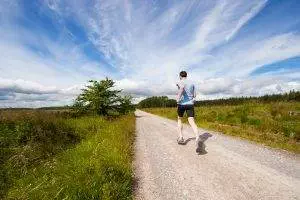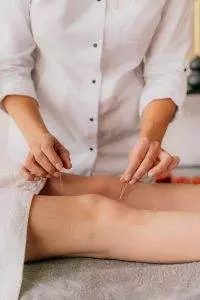By Qineng Tan, L.Ac., Ph.D. and Xiaomei Cai, L.Ac., Ph.D.

Swelling behind knee, lump behind knee, pain and swelling behind knee, knee stiffness? These can be Baker’s cyst symptoms. A Baker’s cyst in knee joint occurs when swelling in the knee forms a fluid-filled sac. Acupuncture treatment can help relieve Bakers cyst knee symptoms like knee pain and stiffness.
A Baker cyst, also known as a popliteal cyst, or synovial cyst, is a fluid-filled growth that develops in the back of the knee joint. In some cases, a Baker’s cyst causes knee pain, stiffness, and swelling; in other cases, there may be no Baker’s cyst signs and symptoms at all.
What causes Baker’s cyst? Usually, it is due to a knee injury, such as a cartilage tear, or arthritis in the knee joint. These types of problems cause inflammation in the knee, which can lead to the production of more synovial fluid than usual.
Synovial fluid is a thick, clear substance, similar to egg whites in consistency, that is present in the joints of the body to help lubricate their movements. It is produced by the synovium, a sort of bubble that surrounds joints like the knees, elbows, shoulders, and hips.
When the synovium becomes swollen and inflamed, due to injury or overuse of the joint, it may produce excess synovial fluid. In the case of a Baker’s cyst, the synovial fluid can build up in the knee joint, and form a bump, lump, or growth in the back of the knee.
People who have a history of knee injury, osteoarthritis, or rheumatoid arthritis may be more prone to developing Baker’s cysts.
Bakers cyst treatment is usually only indicated if a person is experiencing significant pain or limitation of movement. Acupuncture treatment can provide an adjunct or alternative Baker’s cyst therapy to help promote healing and relieve Baker’s knee symptoms.
Top 5 Baker’s Cyst Symptoms

Photo by Jenny Hill on Unsplash
Many people have a baker’s cyst knee without realizing it. If there is no pain, a person may not notice the lump behind knee.
Baker’s cyst signs and symptoms include:
- Knee pain, pain in the back of the knee
- Knee stiffness, stiff knee joint, especially when straightening the leg
- Swollen knee, swelling in knee joint
- Swelling goes away when knee is bent
- Pain and stiffness are worse after standing for a long time
More severe baker’s cyst symptoms could include redness and swelling, as the cyst gets larger.
In some cases, a baker’s cyst can rupture. If this happens, there may be swelling, redness, and a warm sensation in the calf area. Rupture of a baker’s cyst could cause pain or numbness in the calf, lack of blood flow to the lower leg, as the ruptured cyst could trap a nerve or artery in the knee or lower leg.
In extreme cases, a ruptured Baker’s cyst could lead to compartment syndrome, which could cause intense pain, foot drop, edema in the lower leg, and possibly, even an inability to move the foot or toes. If you believe your Baker’s cyst has ruptured, you should seek emergency care.
While, in most cases, a Baker’s cyst will eventually go on on its own, it is best to get a diagnosis and discuss your options. Acupuncture and TCM offer treatment of Baker’s cysts that is non-invasive and can help improve healing and prevent regrowth of the cyst.
Baker’s Cyst Treatment
Baker’s cyst signs and symptoms can be similar to those of a blood clot, or even a tumor. So, while a doctor can often diagnose a Baker’s cyst simply by palpating the area, they may also order imaging tests to be sure.
In many cases, doctors will prescribe over the counter pain medications and allow time for the cyst to go away on its own. You may be advised to limit activities that might aggravate the knee inflammation. Resting and elevating the knee for a few weeks might be recommended.
In some cases, a doctor may give cortisone injections to reduce knee swelling, or perform needle aspiration to drain the fluid from the cyst.
Surgery is generally only suggested in situations in which the knee pain has become chronic and inflammation does not seem to be going away.
Unfortunately, these medical treatments for Baker’s cyst may help bring relief, but it is quite common for the Baker’s cyst to come back again. Acupuncture treatment is not only a good way to bring symptomatic relief, but can help prevent the recurrence of Baker’s cysts.
Acupuncture has long been considered an excellent modality for treating knee pain due to all types of conditions. TCM offers an adjunct or alternative treatment for knee pain, without side effects that can come with pain medications or steroids.
Can Acupuncture Help Baker’s Cyst?

Acupuncture and TCM treatments with Chinese herb formulas have been used for centuries to treat knee injuries of all kinds.
According to TCM theory, arthritis in the knee that causes pain and stiffness is caused by stagnation that blocks the smooth flow of blood and Qi (life force energy). Acupuncture and herbs are used to address the underlying causes of blockages.
Injuries like a torn meniscus in the knee, or damage to the cartilage of the knee are very common, and it is also common for a person who has suffered such an injury to develop a Baker’s cyst later on. Full healing of cartilage can be helped with specific herbs that bring more nutrients to the damaged tissues.
Once a pattern of inflammation has begun, it can be difficult to get the swelling to go away. Small movements can trigger the inflammatory response if the area is not fully healed, and if other lifestyle habits are also causing a person to be prone to inflammation.
Chinese medicine looks at the situation holistically, treating the situation with acupuncture treatment, cupping, herbs, and nutrition, so that overall inflammation is reduced, and swelling and pressure is reduced, as well.
Herbal patches that are applied topically may be used in addition to herbal teas taken internally, to help relieve knee pain and swelling.
Cupping can also be helpful for healing and prevention of Baker’s cysts. One study compared patients with a popliteal cysts who were treated with acupuncture and cupping to patients who were given injections of prednisone. Both groups had high rates of effectiveness in terms of relief from the cysts, but recurrence of Baker’s cyst was significantly lower in the group that received TCM treatment as opposed to steroids.
Acupuncture Near Me for Baker’s Cyst, Los Angeles, CA
If you or someone you know has been suffering from knee pain and stiffness, due to a knee injury, arthritis, or diagnosed with Baker’s cysts on knee, it is worth seeking help from an acupuncturist experienced in working with orthopedic injuries, like Dr. Tan at Art of Wellness in West Los Angeles. TCM treatment for Baker’s cyst and other problems with the knee joint can not only help to relieve pain and increase range of movement; it can help prevent knee pain from coming back in the future.
*This article is for education from the perspective of Traditional Chinese Medicine only. The education provided by this article is not approved by FDA to diagnose, prevent, treat and cure human diseases. It should not stop you from consulting with your physician for your medical conditions. Traditional Chinese Medicine is based on Qi, which is an invisible force that usually cannot be observed by modern science. Because science focuses on testing ideas about the natural world with evidence obtained through observation, these aspects of acupuncture can’t be studied by science. Therefore acupuncture and Chinese herbs are often not supported by double-blind, randomized trials, and they are considered alternative medicine therapies in the United States.
